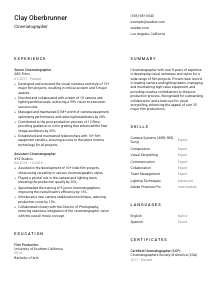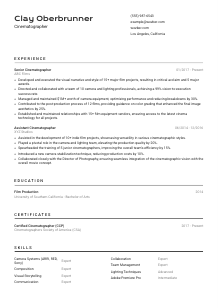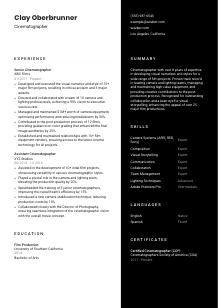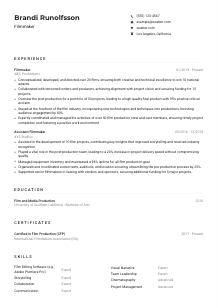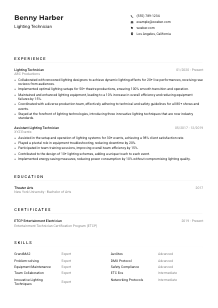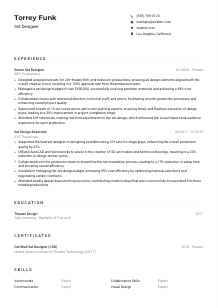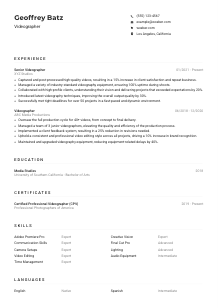Cinematographer Resume Example
Painting scenes with light, but your resume seems dim? Brighten it up with this Cinematographer resume example, designed using Wozber free resume builder. Learn how to frame your camera skills to resonate with job reels, ensuring your career shines as brilliantly as your shots!
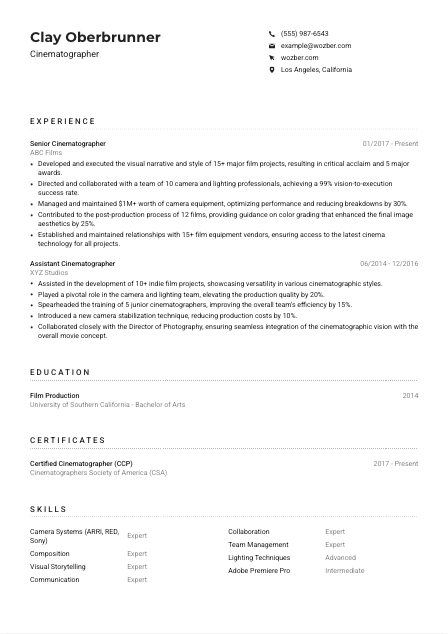
How to write a Cinematographer Resume?
Stepping into the world of Cinematography asks for a blend of artistry and technical prowess, your resume being no exception. In the panorama of job applications, let's sculpt your resume into a masterpiece that not only resonates with your prospective employers but sings in harmony with Applicant Tracking Systems (ATS). With Wozber's free resume builder, including its ATS-compliant resume formats and ATS resume scanner, you're on the path to creating a document that mirrors your unique narrative and skills.
Ready for action? Let's roll!
Personal Details
Your resume opens with Personal Details, setting the stage for your narrative. This initial spotlight is where you encapsulate your essence succinctly, ensuring every detail harmonizes with the role of Cinematographer.
1. Light Up with Your Name
Think of your name as the title of your own blockbuster—it needs to stand out. Opt for a clear, readable font, setting the stage for a professional first impression. Remember, your name sets the tone for the entire script that is your resume.
2. Frame Your Desired Role
Position your desired job title directly beneath your name, akin to a film's subtitle. This reinforces your goal and aligns with the hiring manager's expectations. For aspiration, mirror the job description's language, positioning yourself squarely in the role of "Cinematographer".
3. Ensure Contact Clarity
Your contact information is the call-to-action of your resume's opening credits. A professional email and your best contact number are non-negotiables. Precision here prevents any missed connections in your professional narrative.
4. Locale Alignment
Being in "Los Angeles, California" isn't just a detail; it's an asset. Highlighting your location fulfills a key criterion set out in the job description, reassuring your audience of your logistical compatibility with the role.
5. Digital Footprint
In the realm of Cinematography, a URL to your portfolio can serve as a window to your visual storytelling prowess. Include this link, ensuring it showcases a breadth of skills and styles, speaking volumes before you've even had a chance to.
Takeaway
Polish your Personal Details as if they were the opening frame of your favorite film. They form the first impression and thus, bear the weight of initial judgment. Engage, align, and intrigue—set the scene for a narrative that promises and delivers.





Experience
The Experience section is your storyline, highlighting your journey through the lens of a Cinematographer. It's where you illustrate your script with tangible achievements and project collaborations, resonating with the job at hand.
- Developed and executed the visual narrative and style of 15+ major film projects, resulting in critical acclaim and 5 major awards.
- Directed and collaborated with a team of 10 camera and lighting professionals, achieving a 99% vision‑to‑execution success rate.
- Managed and maintained $1M+ worth of camera equipment, optimizing performance and reducing breakdowns by 30%.
- Contributed to the post‑production process of 12 films, providing guidance on color grading that enhanced the final image aesthetics by 25%.
- Established and maintained relationships with 15+ film equipment vendors, ensuring access to the latest cinema technology for all projects.
- Assisted in the development of 10+ indie film projects, showcasing versatility in various cinematographic styles.
- Played a pivotal role in the camera and lighting team, elevating the production quality by 20%.
- Spearheaded the training of 5 junior cinematographers, improving the overall team's efficiency by 15%.
- Introduced a new camera stabilization technique, reducing production costs by 10%.
- Collaborated closely with the Director of Photography, ensuring seamless integration of the cinematographic vision with the overall movie concept.
1. Analyzing the Script
Begin by breaking down the job description. Highlighting your work on major film projects and your role in them sets a scene of expertise; "Developed and executed the visual narrative of 15+ major film projects…" showcases not just your involvement, but your impact.
2. Casting Your Roles
Chronology matters in storytelling. List your positions starting from the most recent, ensuring each title, company name, and employment period is clearly noted. This clarity in chronology helps frame your career progression with coherence.
3. Scene by Scene
Each role you've undertaken is a scene in your career's storyboard. Detail your accomplishments in a way that echoes the job requirements, quantifying achievements to give them weight. Reflecting on your team management or project successes makes your contribution tangible and real.
4. Audience Impact
Numbers are the universal language of impact. Whenever possible, quantify your achievements to give the hiring manager a clear view of your impact scale, such as "reducing equipment breakdowns by 30%" or "enhancing final image aesthetics by 25%".
5. Scene Selection
Maintain focus; detail only the experiences that directly spotlight your qualifications for the Cinematographer role. Each bullet point should serve the narrative, propelling your candidacy forward without extraneous subplots.
Takeaway
Craft your Experience section as if directing a film where each role is a pivotal scene. With every bullet point, you're not just narrating your past but pitching your capability for future projects. Ensure each tale of achievement clearly projects your fit for the role in focus.
Education
The Education section isn't merely a backdrop; it's the foundation of your expertise in Cinematography. Here, you convey the academic rigors you've survived and the knowledge you've amassed on your journey.
1. Focusing on Requirements
Identify the education benchmarks within the job listing. A "Bachelor's degree in Film Production, Cinematography, or related field" acts as your minimum setting, grounding your expertise in a recognized academic context.
2. Crafting Your Credentials
Present this section with a clear and straightforward script: your degree, the awarding institution, your field of study, and graduation date. Simplicity here allows for easy scanning, whether by human eyes or an ATS.
3. Matching the Lens
Your education should mirror the job's requirements as closely as possible. Listing "Bachelor of Arts in Film Production" directly aligns with the expectations, showcasing your preparedness for the role.
4. Additional Aperture
While the focal point of your education is your degree, including relevant courses or achievements can enhance the resolution of your educational background. However, prioritize relevance over quantity to keep your narrative focused.
5. Scene Enhancers
Relevant extracurricular activities, honors, or society memberships can add depth to your educational storyline, provided they align with the cinematic narrative you're crafting. Assess the role's seniority level to ensure these details enhance rather than clutter your scene.
Takeaway
Your Education section underpins your technical and theoretical mastery in the field of Cinematography. Craft this segment to resonate with the job's specified qualifications, ensuring it validates your candidacy with academic gravitas.
Certificates
Like accolades at a film festival, certificates highlight your dedication to craft and continuous learning. They're special features on your resume, underscoring your commitment to advancing your expertise.
1. Reviewing the Script
First, assess the job description for any listed certificate preferences or requirements. While the provided Cinematographer role doesn't specify certifications, aligning your listed certificates with industry standards speaks volumes.
2. Curating Your Collection
Choose to showcase certificates that carry weight within the cinematic domain. A certification like "Certified Cinematographer (CCP)" directly aligns with industry recognition, immediately signaling your credibility and dedication.
3. Chronological Order
For certificates, especially those renewed over time, including the validity period showcases your commitment to staying current. An ongoing certification underscores not just achievement but dedication to continuous improvement.
4. Always in Focus
The cinematic landscape continuously evolves, as should your skill set. Keep your certifications up to date, seeking opportunities that bolster your expertise and signal to potential employers your commitment to excellence.
Takeaway
Your certificates, like awards at a film festival, underscore your expertise and dedication to your craft. Choose wisely which to showcase, focusing on those that best align with the Cinematographer role and the broader industry standards.
Skills
The Skills section of your resume is your tech kit mixed with your art kit—a blend of the tools and flair at your disposal. This segment is crucial in framing your versatility and uniqueness in the role of a Cinematographer.
1. Decoding the Script
Kick-off by identifying the skills explicitly listed in the job description, alongside those implicitly required. Skills such as "Expertise in various camera systems" and "Strong understanding of lighting techniques" are direct lifts from your job directive and should be mirrored in your skill set.
2. Lighting and Framing Your Skills
List both your technical skills (like proficiency in specific camera systems) and your soft skills (like team management and communication). This blend showcases not just your ability to capture stunning imagery, but also your capacity to lead and collaborate effectively.
3. Keeping the Scene Clean
Resist the temptation to list every skill you possess. Instead, spotlight the most relevant ones that would captivate the hiring manager's interest. The emphasis should be on quality, not quantity, to keep your skill section sharp and engaging.
Takeaway
Your Skills section is a brief yet potent testament to your capability as a Cinematographer. It's your chance to exhibit not just the mastery of your craft but also the harmony you bring to a team. Display your skills with both pride and precision, ensuring they direct the narrative towards your proficiency and uniqueness.
Languages
In a field as globally interconnected as Cinematography, the ability to speak multiple languages can significantly enhance your communication on set and with international crews. This section illuminates your global readiness and adaptability.
1. Script Analysis
Examine the job description for any specific language requirements or advantages. Stating your "English fluency" as a "core competency" instantaneously aligns with the job's demands, setting a solid baseline for communication skills.
2. Highlighting Your Linguistic Arsenal
Lead with languages essential to the role, underpinning your primary communication tool. Subsequently, list other languages you know, underscoring your versatility and potential to engage with diverse creative teams or international projects.
3. Directing Clarity in Proficiency
Articulate your language skills with transparent grading, from 'Native' to 'Basic'. This clarity arms the hiring team with insights into your capability for nuanced communications or cultural adaptability, essential in collaborative settings.
4. Global Casting
For roles that have an international lens or involve collaboration across borders, your multilingual proficiency becomes an asset, painting you as a global thinker ready for a wide range of directorial visions.
5. Continuous Learning
The world of cinema, much like language itself, is ever-evolving. Embody a spirit of continuous learning and exploration, enriching not just your linguistic repertoire but also your cinematic vision.
Takeaway
Your ability to communicate across languages is not just a line on your resume; it's a testament to your readiness to engage in a global dialogue, essential in the collaborative world of film. Treat this section as you would a diverse cast—each language a unique voice that contributes to the richness of your narrative.
Summary
The Summary section is your elevator pitch, the teaser trailer to the epic that is your career. It's where you crystallize your experience, skills, and uniqueness into a compelling narrative that captures the essence of your candidacy for the Cinematographer role.
1. Visualize the Frame
First, absorb the job description, understanding its essence. This mental reframe helps distill what facets of your career story will resonate most strongly with the demands of the Cinematographer role.
2. Set the Scene
Begin with an introductory statement, encapsulating your professional identity and the length and breadth of your experience. This snapshot should immediately signal to hiring managers your eligibility and passion for the cinematography craft.
3. Lighting the Key Points
Illuminate your path through specific achievements and skills that match the job's requirements, showcasing the distinct impact you've made in your field. Highlighting project successes such as "achieving a 99% vision-to-execution success rate" serves as a showcase of your competence and vision as a Cinematographer.
4. The Final Cut
Keep this section tight and engaging. In 3-5 lines, you want to hook the hiring manager's interest, given them a glimpse of your cinematic journey, and leave them wanting to know more about you.
Takeaway
Your Summary is the gateway to the narrative of your career. It's the brief yet vibrant highlight reel that entices hiring managers to delve deeper into your story. Tailor it to reflect the key aspects of the Cinematographer role, letting it serve as the perfect introduction to your professional saga.
Lights, Camera, Action: Launching Your Cinematographer Journey
Congratulations on completing this cinematic journey through crafting a tailored Cinematographer resume. Harness the power of Wozber's free resume builder, ATS-friendly resume templates, and ATS resume scanner as you fine-tune your document. Your resume is now set to not just pass the ATS scrutiny but to captivate the imaginations of hiring managers. Remember, each section of your resume is a frame in the story of your career.
Adjust the focus, control the exposure, and ensure that your narrative shines brightly. The stage is set, the scene is yours to command—step forth and turn your professional aspirations into celebrated achievements.

- Bachelor's degree in Film Production, Cinematography, or a related field.
- Minimum of 5 years experience in cinematography, with a portfolio demonstrating a broad range of cinematographic skills and styles.
- Expertise in working with a variety of camera systems and familiarity with the latest cinema technology.
- Strong understanding of lighting techniques, composition, and visual storytelling.
- Excellent communication, collaboration, and team management skills.
- English fluency is a core competency for this position.
- Must be located in Los Angeles, California.
- Develop the visual narrative and style of the project in collaboration with the Director.
- Determine camera angles, movement, and lighting requirements to ensure the desired cinematic effect.
- Direct and collaborate with the camera and lighting team to execute the vision.
- Manage and maintain camera equipment, ensuring optimal performance and safety.
- Contribute to the post-production process, providing guidance on color grading and final image aesthetics.





